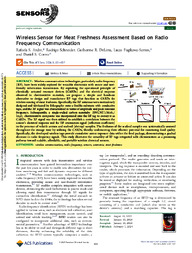Wireless Sensor for Meat Freshness Assessment Based on Radio Frequency Communication.
Wireless Sensor for Meat Freshness Assessment Based on Radio Frequency Communication.
Autoria: ANDRE, R. S.; SCHNEIDER, R.; DeLIMA, G. R.; FUGIKAWA-SANTOS, L.; CORREA, D. S.
Resumo: Wireless communication technologies, particularly radio frequency (RF), have been widely explored for wearable electronics with secure and userfriendly information transmission. By exploiting the operational principle of chemically actuated resonant devices (CARDs) and the electrical response observed in chemiresistive materials, we propose a simple and hands-on alternative to design and manufacture RF tags that function as CARDs for wireless sensing of meat freshness. Specifically, the RF antennas were meticulously designed and fabricated by lithography onto a flexible substrate with conductive tape, and the RF signal was characterized in terms of amplitude and peak resonant frequency. Subsequently, a single-walled carbon nanotube (SWCNT)/MoS2/ In2O3 chemiresistive composite was incorporated into the RF tag to convey it as CARDs. The RF signal was then utilized to establish a correlation between the sensor’s electrical response and the RF attenuation signal (reflection coefficient) in the presence of volatile amines and seafood (shrimp) samples. The freshness of the seafood samples was systematically assessed throughout the storage time by utilizing the CARDs, thereby underscoring their effective potential for monitoring food quality. Specifically, the developed wireless tags provide cumulative amine exposure data within the food package, demonstrating a gradual decrease in radio frequency signals. This study illustrates the versatility of RF tags integrated with chemiresistors as a promising pathway toward scalable, affordable, and portable wireless chemical sensors.
Ano de publicação: 2025
Tipo de publicação: Artigo de periódico
Unidade: Embrapa Instrumentação
Palavras-chave: Wireless communication
Observações
1 - Por padrão são exibidas publicações dos últimos 20 anos. Para encontrar publicações mais antigas, configure o filtro ano de publicação, colocando o ano a partir do qual você deseja encontrar publicações. O filtro está na coluna da esquerda na busca acima.
2 - Para ler algumas publicações da Embrapa (apenas as que estão em formato ePub), é necessário ter, no celular ou computador, um desses softwares gratuitos. Sistemas Android: Google Play Livros; IOS: iBooks; Windows e Linux: software Calibre.
Acesse outras publicações
Acesse a Base de Dados da Pesquisa Agropecuária (BDPA) para consultar o acervo completo das bibliotecas da Embrapa.

